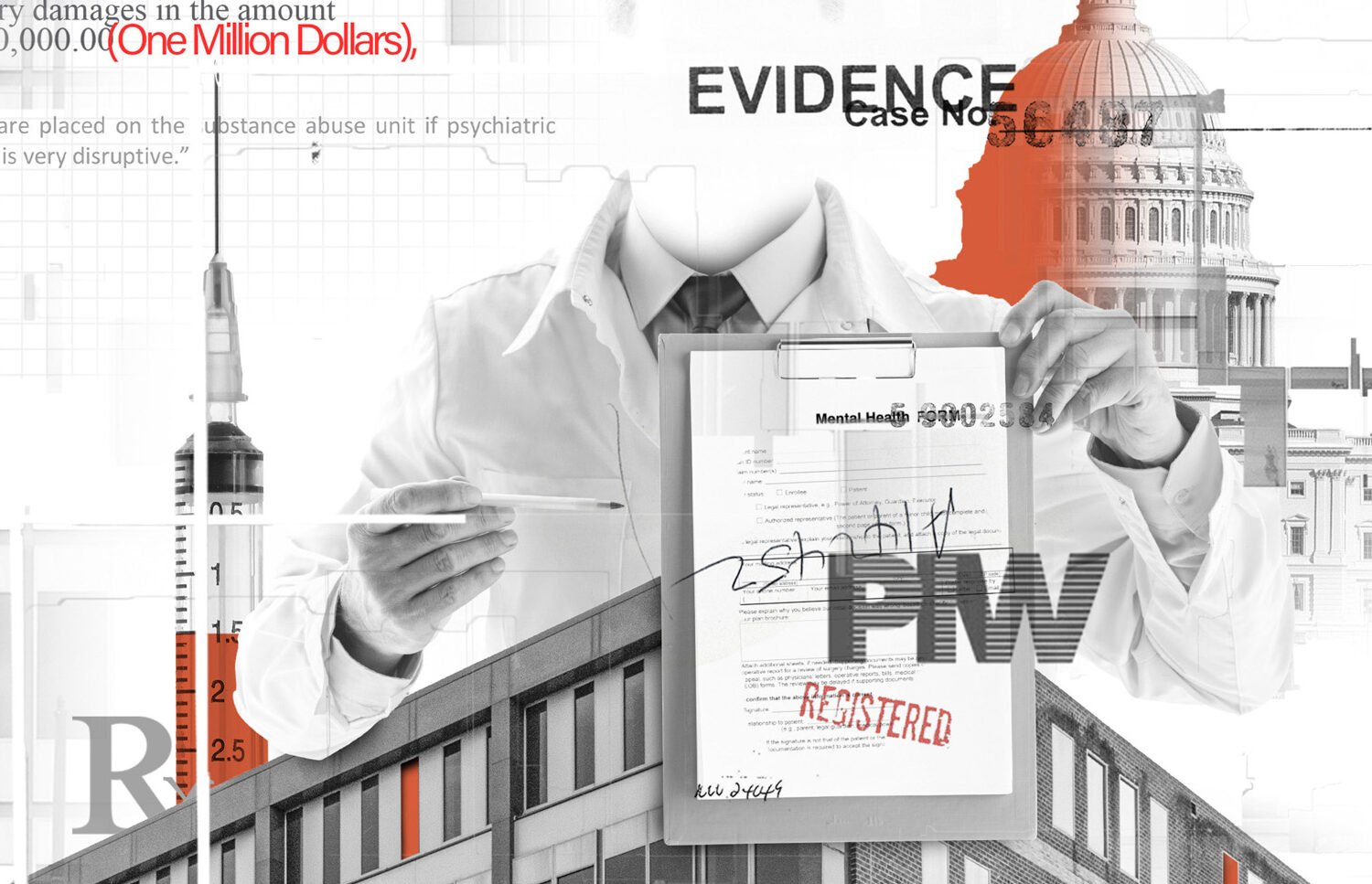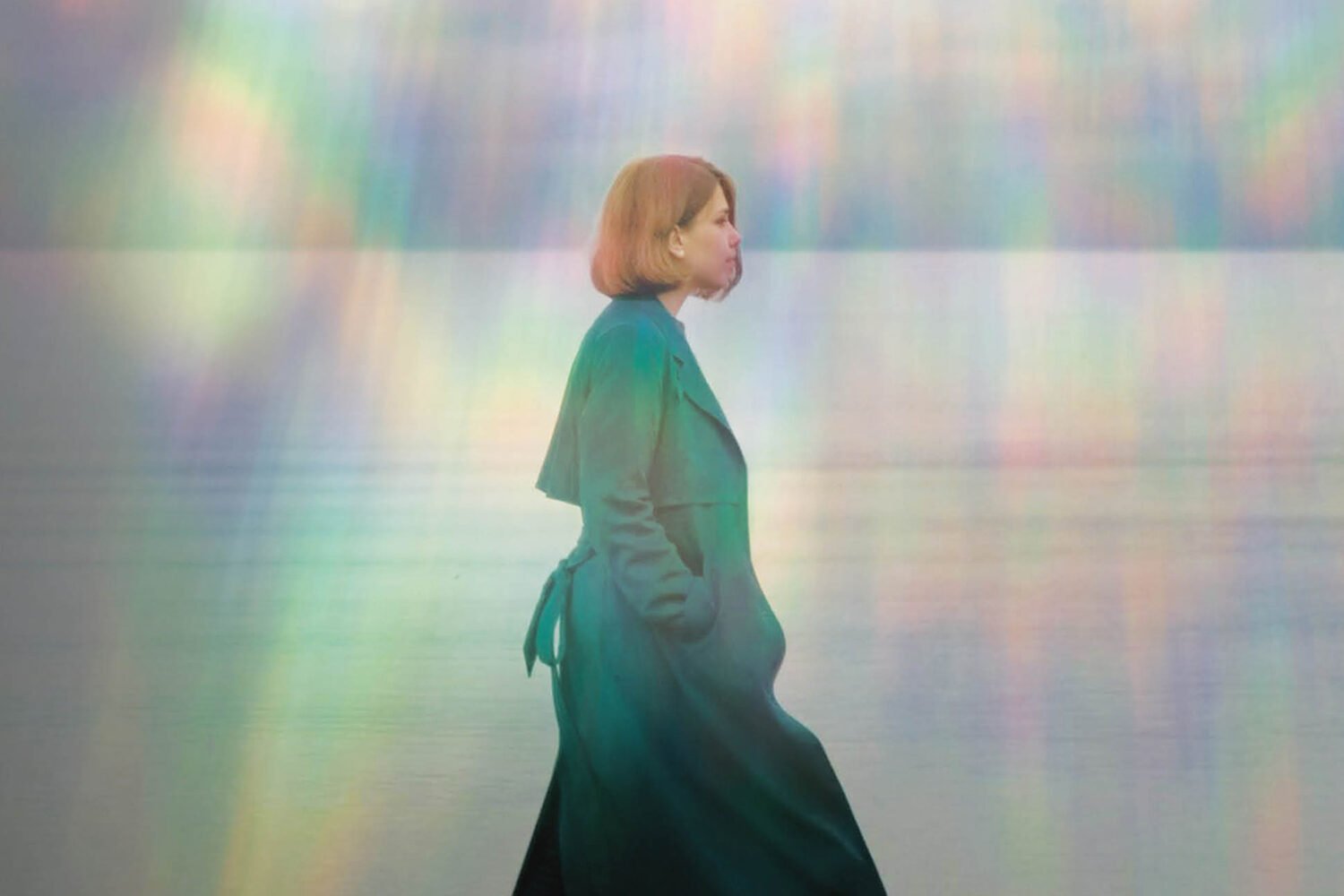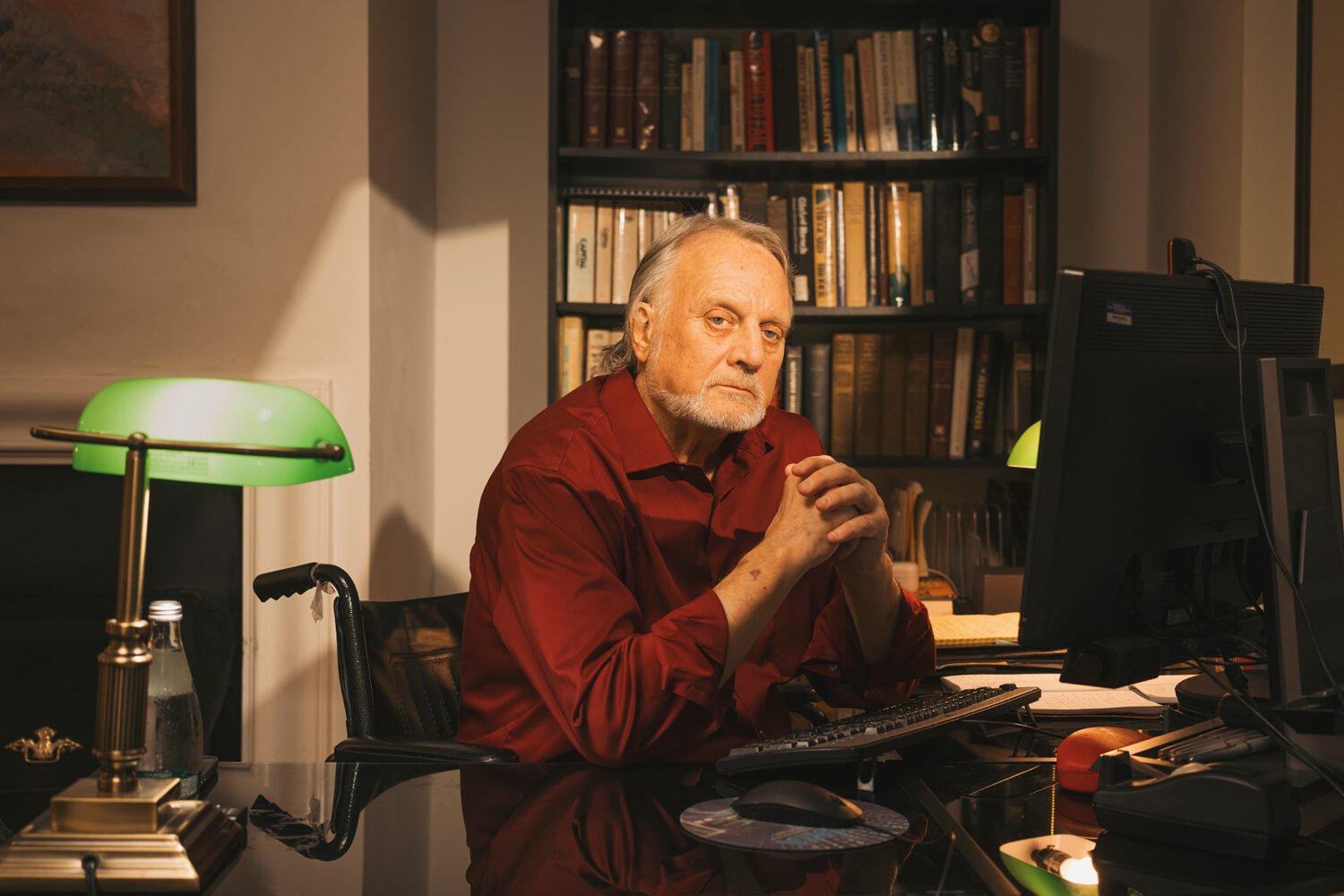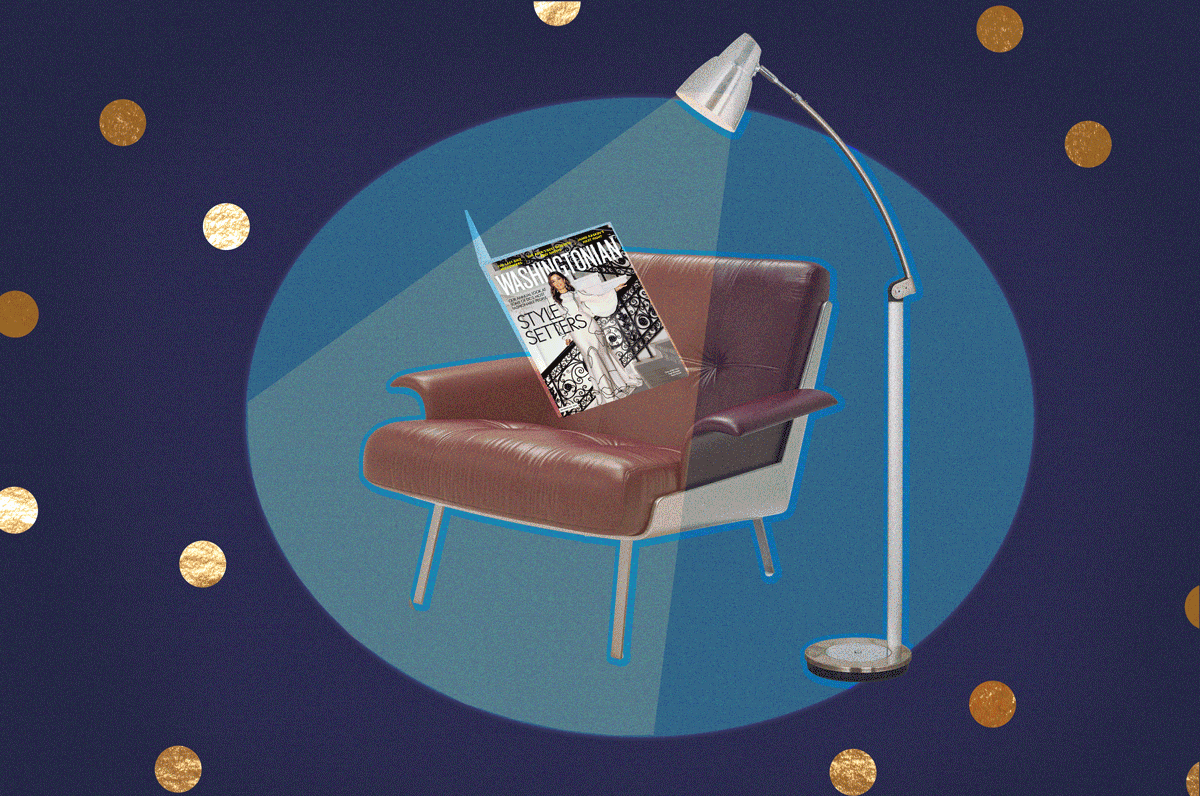
After
businessman Jacob Einstein bought a Bethesda easy-listening radio station in the late 1960s and encouraged his DJs to play whatever they wanted, WHFS cultivated a Washington-area audience of oddballs and music obsessives. But in 1991, Nirvana’s Nevermind became an era-defining hit, and the station—which had long played what was then called “alternative rock”—was uniquely positioned to ride the musical and cultural waves left in the album’s wake.
Robert Benjamin joined WHFS as its program director around the same time, professionalizing its playlists as ratings skyrocketed. With sorority sisters singing along to the Butthole Surfers and minivans in the burbs rocking to Archers of Loaf, the time was right to bring alt-rock’s many tribes together—the gentle indie-rock kids, the moshing bros, the goths allergic to sunlight, the crusty punks with dogs on strings, the bewildered friends. WHFS already had thrown two Fourth of July barbecues at Lake Fairfax Park in Reston, but Benjamin thought the event could be much bigger.
He was right. Landing at RFK Stadium on July 3, 1993, the HFStival became an annual phenomenon, attracting an average of 58,000 people while serving as a template for similar shows across the country. Later, when the event moved to football stadiums outside the city and in Baltimore, as many as 90,000 people attended.
By the early aughts, however, the good vibes started to fade. The music got darker and angrier. So did the crowds. In 2005, WHFS abruptly went off the air, its call sign since bouncing between cities and formats. The HFStival sputtered and disappeared, Generation X’s brief moment of cultural relevance fading into a very on-brand disappointment.
Still, nostalgia persists—to the point that local concert giant I.M.P. has announced plans to revive the event at Nationals Park in the fall. More than a chance to see Foo Fighters, Garbage, and No Doubt perform on the same stage, the original HFStival was a case study of niche culture going mainstream, and an optimistic salve for a pessimistic generation.
Washingtonian spoke to musicians, on-air personalities, fans, and suits about the rise and fall of a you-had-to-be-there experience.
I. In Utero
WHFS’s tradition of freeform radio changed after Nirvana’s breakout, which showed major labels that they could vacuum up the audience that punk and indie bands had built. Suddenly, the quirky little station became a contender on Washington’s airwaves.
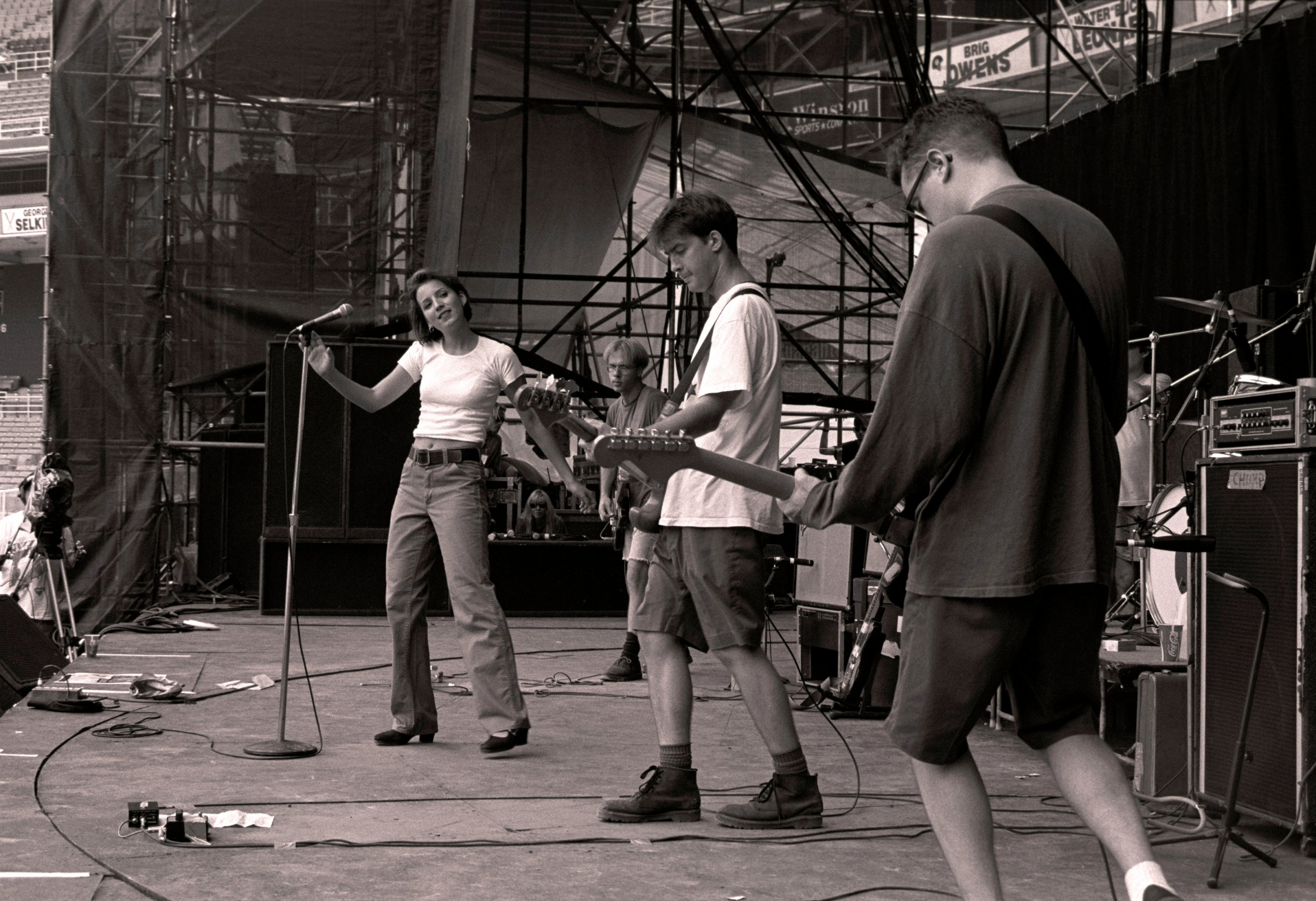
Bob Waugh, WHFS assistant program director, 1991–2004: We had this signature line: “99.1 WHFS: Less music by dead guys.”
Eric Axelson, musician, the Dismemberment Plan: All of us grew up listening to HFS. It was kind of a North Star for us because it wasn’t [classic-rock station] DC101 and it wasn’t [Top 40] Q107. It was playing R.E.M., it was playing the Alarm and stuff we weren’t gonna hear elsewhere.
Bill Barbot, musician, Jawbox: I grew up listening to HFS. That was where I learned about music, like, the first time I ever heard Mission of Burma.
Robert Benjamin, WHFS program director, 1991–2003: Alternative rock was about to explode. We brought in a number of really talented people. The festival grew out of that.
The station’s first Fourth of July festival was held at Lake Fairfax Park in 1990. Fifteen thousand attendees saw performers including Concrete Blonde and the Tragically Hip. The next year, 25,000 came to see a lineup that included the La’s and the Violent Femmes.
Benjamin: The [station] had done a basic Fourth of July show and picnic—fireworks, swimming. My thought was let’s make it be about a lot of bands and really identify it with the station. At the last moment, when we were designing T-shirts, I decided I didn’t want to be stuck doing a Fourth of July show every year. I just wrote down “HFStival on the Fourth of July.” And maybe we could move this thing somewhere else, make it bigger. So it was the second annual HFStival, even though there had never been one before.
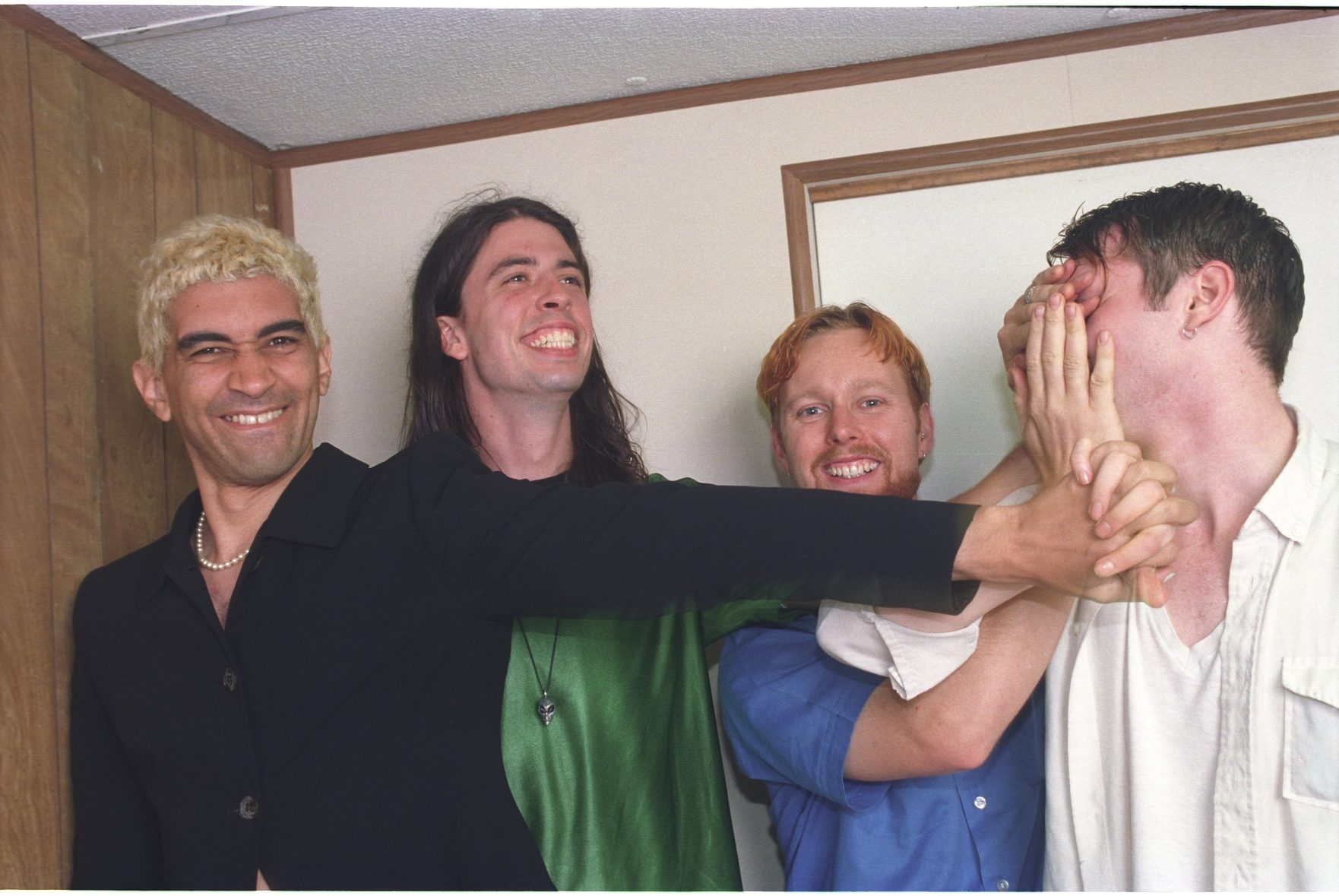
Pat Ferrise and Dave Marsh, two former West Virginia University students who had landed jobs at WHFS, worked the 1991 event.
Pat Ferrise, WHFS music director and DJ, 1990–2005: The La’s played. I don’t want to say they stole a golf cart—
Dave Marsh, WHFS DJ, 1990–99: They stole a golf cart.
Ferrise: They commandeered a golf cart. They were 20-year-old crazy British guys.
Marsh: There was that pizza-box thing.
Axelson: There was a Domino’s stand, and people started ripping boxes in half and throwing them in the air. So it was raining cardboard and plastic bottles. It got weirdly scary for a minute.
In 1992, the HFStival moved to the Prince George’s Equestrian Center in Upper Marlboro. The lineup included the Soup Dragons, the Charlatans UK, They Might Be Giants, and local band Manifesto. Thirty-two thousand people attended.
Ferrise: It sold out pretty quickly.
Benjamin: I remember sitting in a trailer with state troopers and the racetrack people, and they were saying, “We’ve got to shut this down. There’s too many people coming.”
Waugh: There were massive traffic backups.
Axelson: The ground was just, like, dirt. It just felt like Pig-Pen from Charlie Brown.
Geoff Sanoff, musician, Edsel: Our bandmate Nick was the keyboard player in Manifesto, and [working as Manifesto’s crew] was an excuse to get in for free. It was so dusty, a really hot day, and they had this air-conditioned VIP area. And the idea that we could drink endless amounts of anything we wanted. It’s like, “Wow, now we’re playing with the big boys.”
Sohrab Habibion, musician, Edsel: I realized immediately that I never wanted to be on the other side.
II. Automatic for the People
Because of the 1992 event’s size, the Equestrian Center asked WHFS to find another venue for its next festival.

Robert Benjamin, WHFS: We talked to the people at [local concert-production company] Cellar Door. They kept saying, “We really think RFK Stadium is the place for you guys.” It didn’t feel like putting it in a stadium was right—we were concerned about the vibe. They said, “Come check out this Grateful Dead show we’re going to do.” It was interesting, because they took the tickets at the outer perimeter. Once you were in, you could go wherever you wanted—parking lots, you could sit in the stands, you could come down on the field.
Bob Waugh, WHFS: We thought long and hard and concluded that if we could get the right band to headline, we could give it a shot.
Benjamin and Waugh got a tip that the Australian band INXS might be amenable to headlining a festival at RFK.
Pat Ferrise, WHFS: They were on the other side of the apex, but they were still really big. Bob and I went to Philadelphia and met with them. They played in a small club. We went backstage afterwards, and [lead singer] Michael Hutchence was very quiet and nice. And the management, they’re being really serious. We’re thinking, “Hey, we’re offering you a chance to play a stadium. Come on.”
Waugh: I shared a limousine with Hutchence and [guitarist] Tim Farriss. We drove down to DC and went to Tower Records in Georgetown. And we announced that INXS was going to headline that year at HFStival.
WHFS booked a mix of acts it was championing at the time, like Stereo MC’s, Matthew Sweet, and the Posies, as well as heritage acts like Iggy Pop to broaden the festival’s appeal. Crucially, it set the ticket price at $12.
Benjamin: We wanted to be $1 a band. We sold out the show with about a week to spare.
Ferrise: That was part of the HFS relationship with the audience, like, “Hey, we’re all scrappy underdogs, no one’s trying to gouge you, these are some cool bands for not a lot of money.”
Local indie-rockers Velocity Girl, who’d recently signed to Nirvana’s old record label, Sub Pop, were tapped to open the show on July 3, 1993. Fifty-six thousand attended.
Jim Spellman, musician, Velocity Girl: We had to get there quite early. I remember how weird it was driving into the bowels of RFK. Most other bands had big buses and trucks, and we had our dinky Dodge van with the plywood loft in back.
Ferrise: I’d only seen [Velocity Girl] at the 9:30 Club. They sounded great [at RFK]. I was struck how they were able to pull it off, because playing a big stadium is a very different experience.
Spellman: After we finished playing, the rest of the day became a race to somehow stay drunk for eight hours. We quickly depleted our assigned allotment of booze. While Stereo MC’s was performing, we snuck into their dressing room and stole a bunch of beer. We stole a bottle of Jack Daniel’s from Matthew Sweet—apologies to him and his band.

III. Different Class
The festival returned to RFK in May 1994 with a crowd of 58,000 and two stages: an “inner” stage in the stadium for bigger acts (Cracker, Counting Crows, Pavement, Rollins Band, Toad the Wet Sprocket) and an “outer” stage in the parking lot for smaller ones (Edsel, Gigolo Aunts, the DC band Tuscadero).

Phil Satlof, musician, Tuscadero: We borrowed our friend’s Astro van—his mother was a florist. And we got lost because I don’t think any of us had ever driven to RFK before. There were big guys with headsets and clipboards. I don’t think we had played outdoors yet. There were probably four to five hundred people milling about—a lot of dudes with no shirt and ’90s haircuts.
Dave Marsh: Each DJ would be assigned to introduce a band, you would do the stage announcement. And so, Robert, in all of his wisdom, he would try to pair you up with a band who thought most fit what your image was.
Gina Crash: A lot of times people really didn’t see their favorite DJs unless they were up in front of a Jumbotron with 65,000 people. So they’d be like, “Oh, that’s what Crash looks like.” So it was definitely a different time.
Geoff Sanoff, musician, Edsel: I’d gotten into a car accident about a month before the show. And we each got four tickets. I needed to pay to get my car fixed, so I sold them for $300. I was going to sell my backstage pass—I could have gotten, like, $40 or $50—but I gave it away to some kids who were trying to get in, because I thought it would be funny to let them get backstage.
Sohrab Habibion, musician, Edsel: MTV covered it. We got interviewed. But you know, we were the first band and it was that thing, like, nobody gives a shit about anybody who’s playing in the parking lot except our friends.
Sanoff: My mom cared.

Inside the stadium, the crowds were much bigger—but the event still retained much of its low-fi charm.
Pat Ferrise, WHFS: Counting Crows was a cool moment. That day, it rained. I think we had to delay the show for a minute, but I just remember the rain adding a cool effect to their performance. It wasn’t like a downpour, it was just enough rain that it kind of seemed intentional.
Sean Daly, Washington Post pop-music critic, 2004–05: Toward the end of the event, a balmy DC night, surly seat dwellers started raining bottles at people on the field. My then-girlfriend decided we should go back to protect ourselves from the onslaught. She said, “Duck,” and we ducked! Then a bottle came at me—but I didn’t say, “Duck.” She got whacked in the noggin. So much for heroism!
IV. You’ve Come a Long Way, Baby
For the rest of the ’90s, the HFStival was a major event, drawing a who’s who of the decade’s headliners and one-hit wonders: Bush and Better Than Ezra, Everclear and Gin Blossoms, Beck and Jewel, Green Day and Jamiroquai, Wyclef Jean and Third Eye Blind, the Goo Goo Dolls and the Red Hot Chili Peppers.
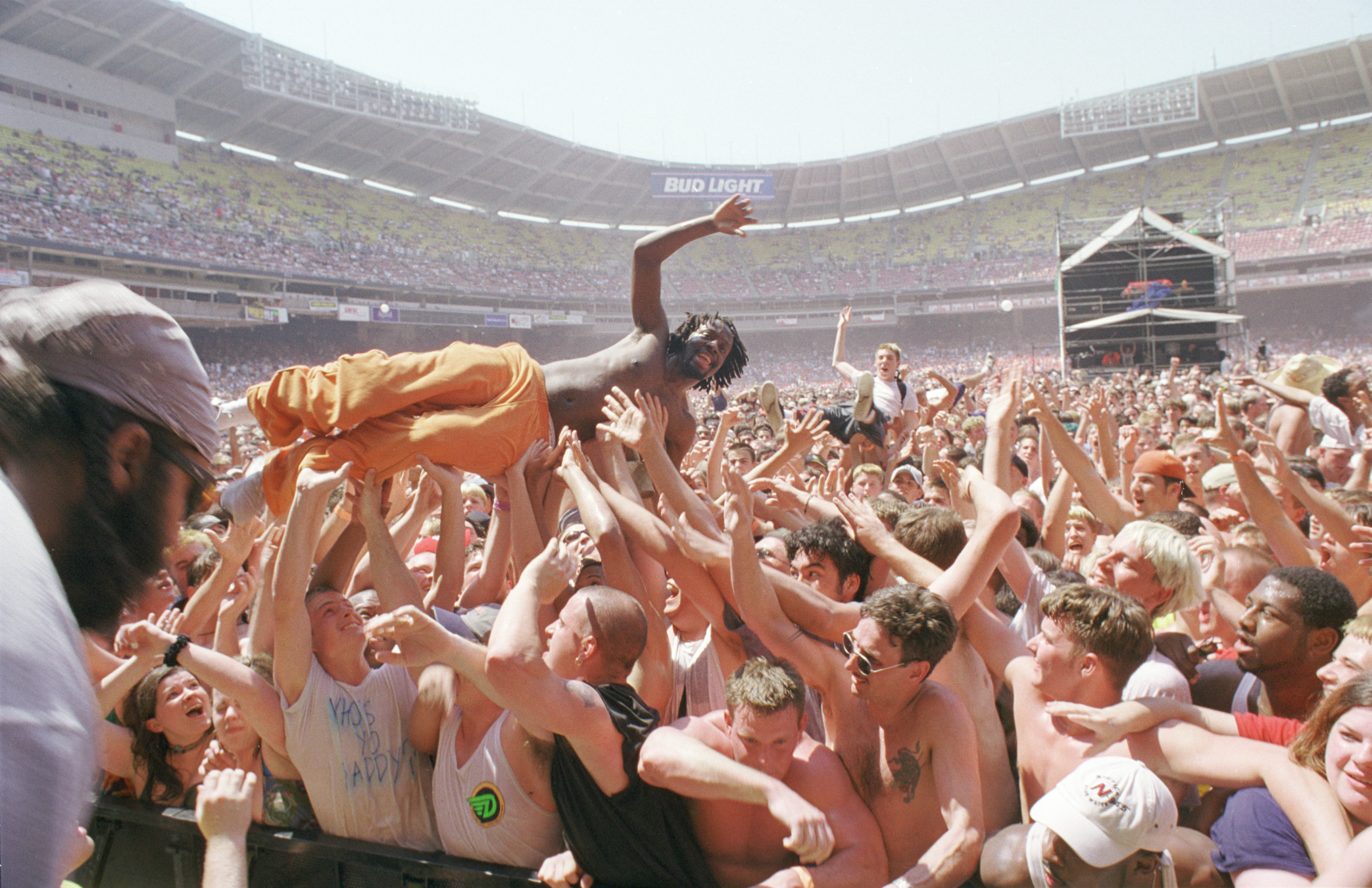
Bob Waugh, WHFS: One thing that was a big help was a company called SoundScan, which measured record sales every day. All the record companies cared about was how many records they could sell. And what we saw on a pretty consistent basis was that any band that played the HFStival, that following Monday or Tuesday when the SoundScan report was released, their record sales were through the roof in DC.
To help bring in acts, WHFS staffers worked to make the backstage as comfortable as possible—no mean feat in an aging RFK Stadium.
Gina Crash, WHFS DJ, 1992–2002: I know a lot of people complain about RFK being in a state of disarray, but I feel like it always was in an endearing kind of way. You know, just little pieces of the roof would fall off while you’re talking.
Bill Barbot, Jawbox: It felt like a completely different venue to me. I had been to a couple of Redskins games when I was little because my dad’s company had season tickets. The environments of a football game at RFK versus a rock festival at RFK were so completely and utterly different. You feel compelled to fill up all this space.
Pat Ferrise, WHFS: The idea was to go above and beyond to make bands know how appreciated they were. The food was really good. And the whole setup just looked like you’re walking into a magical hippie restaurant by the sea.
Eric Axelson, the Dismemberment Plan: Aveda had a setup backstage where you could get haircuts or a massage. I was on the chair next to [Echo & the Bunnymen singer] Ian McCulloch. He was getting a trim, and his manager was chatting him up before their set about like the right time to take his sunglasses off for maximum impact. He’s like, “Right mate, during the chorus, pull them off right when the chorus kicks in, and the crowd’s going to go batshit.” And he did, and they did.
Waugh: We went out of our way to honor their hospitality riders to the T. Artists would fuck around and request things just to see if we would get it for them. Everclear one year said, “We would like a small dog.” And we made it happen.
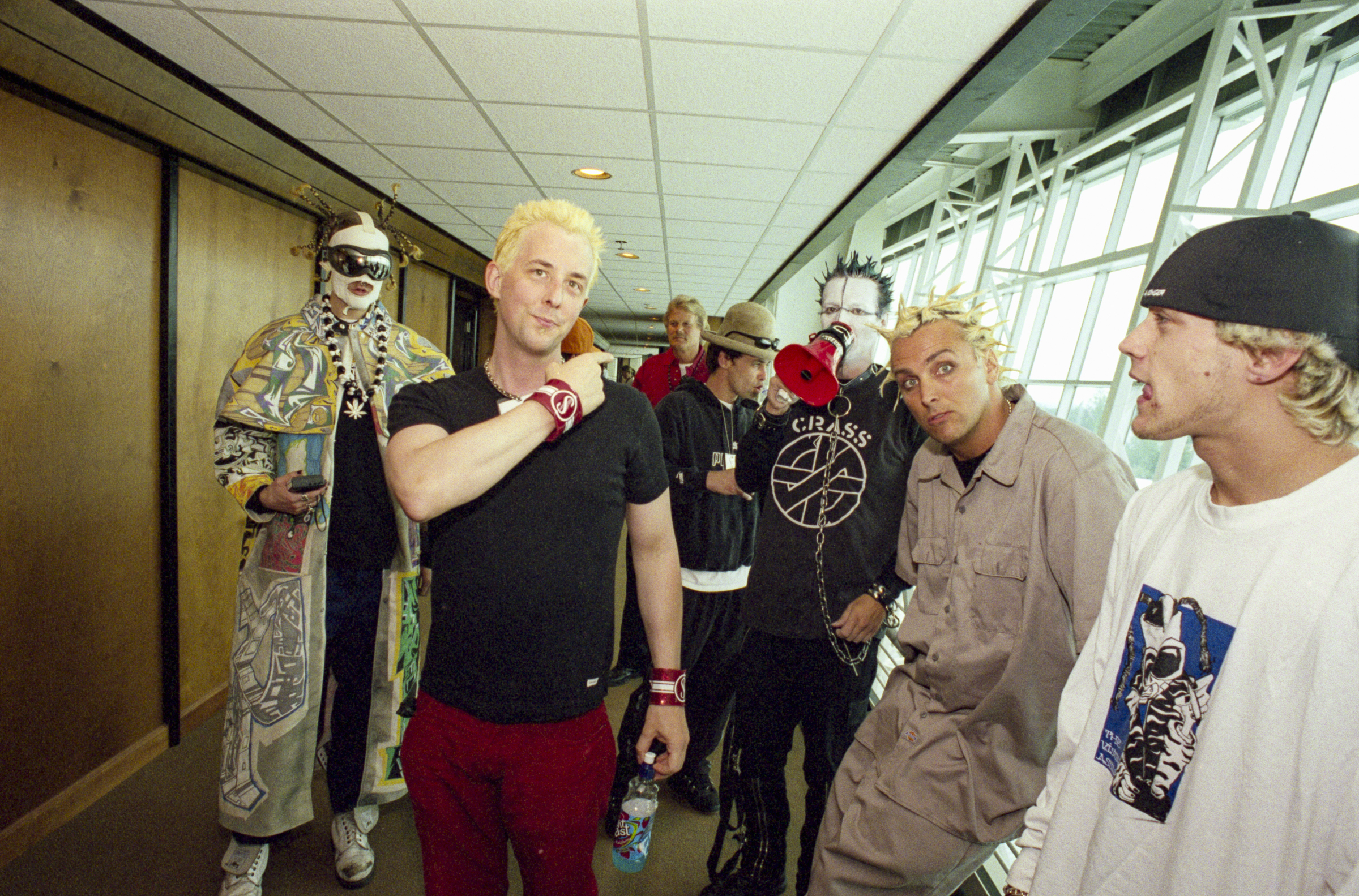
Dave Marsh, WHFS: At a big festival, the bands show up, do their sets, and then leave. At HFStival, the bands would stay the entire time. I remember Iggy Pop saying in an interview that day, “Yeah, it’s great, it’s like a giant hang.”
Barbot: That’s kind of what the HFStival did: It threw a bunch of us who weren’t in that world into that world, and tried to see what would happen.
Waugh: The lead singer of Soul Asylum, Dave Pirner, was dating Winona Ryder [in 1995]. My walkie-talkie goes off and I’m told that Winona Ryder would like to have a word with Les Claypool of Primus. And I’m like, “Okay.” Winona Ryder confronts Les Claypool and says, ‘What the fuck?’ Because Primus had this song out called “Wynona’s Big Brown Beaver.” It’s not even spelled the same way as her name. I’m just standing there watching this, thinking, What the fuck is happening here? Les Claypool just kind of laughed it off. She had her say and split. I never saw her again that day.
V. Viva! La Woman
The HFStival had its share of snafus and drama. In 1996, Jewel walked off the stage in the middle of her second song after getting hit in the chest by a Frisbee. In 1999, the Red Hot Chili Peppers nearly refused to play after hearing that the band preceding them, the Offspring, was planning to ask the crowd to pelt the stage with trash at the end of their set. Then there was Courtney Love, a “special guest” at the 1995 event alongside Tony Bennett.

Juliana Hatfield, musician, the Juliana Hatfield Three: She was her usual hot glorious mess of a whirlwind. And it was exciting. You know, she had that real rock thing and voice.
Bob Waugh, WHFS: I’ve got a million stories that nobody knows, like Courtney Love having to share a dressing room with Tony Bennett and flashing him, and Tony Bennett just being completely nonplussed.
Dave Marsh, WHFS: I didn’t see the flashing. But they were both there. I step out into the hallway and there’s nobody in it, except Tony is coming this way. Courtney is coming the other way. I’m in the middle. She was dressed in this kind of negligee, and Tony was in an ascot and a smoking jacket. Courtney was almost hanging on the wall. They acknowledged each other and carried on.
Robert Benjamin, WHFS: She came out and did a couple songs and then jumped into the mosh pit.
The Washington Post, June 4, 1995: “[Love] emerged a minute later, her dress shredded, and unleashed a burst of expletives at the audience, challenging one member, ‘Come up here—I’ll kick your butt!’ And then she was gone, hustled offstage by a few beefy security types.”
Hatfield: We decided that right after our last song, we were all going to dive into the crowd together. The crowd just caught us and put us all back on the stage. And then we just walked out because it was pretty successful.
Benjamin: Tony Bennett’s philosophy was there’s good music and bad music. And there’s no reason why people that like the Red Hot Chili Peppers can’t like Tony Bennett as well. The crowd was very active in the mosh pit. I remember talking to his son, and he said, “Don’t embarrass my father.” The Ralph Sharon Trio started playing. Tony walked out, grabbed the mic like a pro. The crowd went completely reverent. He just killed it in front of 50,000 people that had spent a good bulk of the day moshing.
VI. The Downward Spiral
Around the turn of the millennium, the HFStival peaked—the 1999 event was actually two shows, one at Baltimore’s PSINet Stadium (now M&T Bank Stadium) in the spring and one at RFK in the fall, while the 2000 show moved to FedEx Field in Maryland and drew 90,000 people. Still, trouble was brewing: Rock was losing its cultural cachet, and so was HFS.
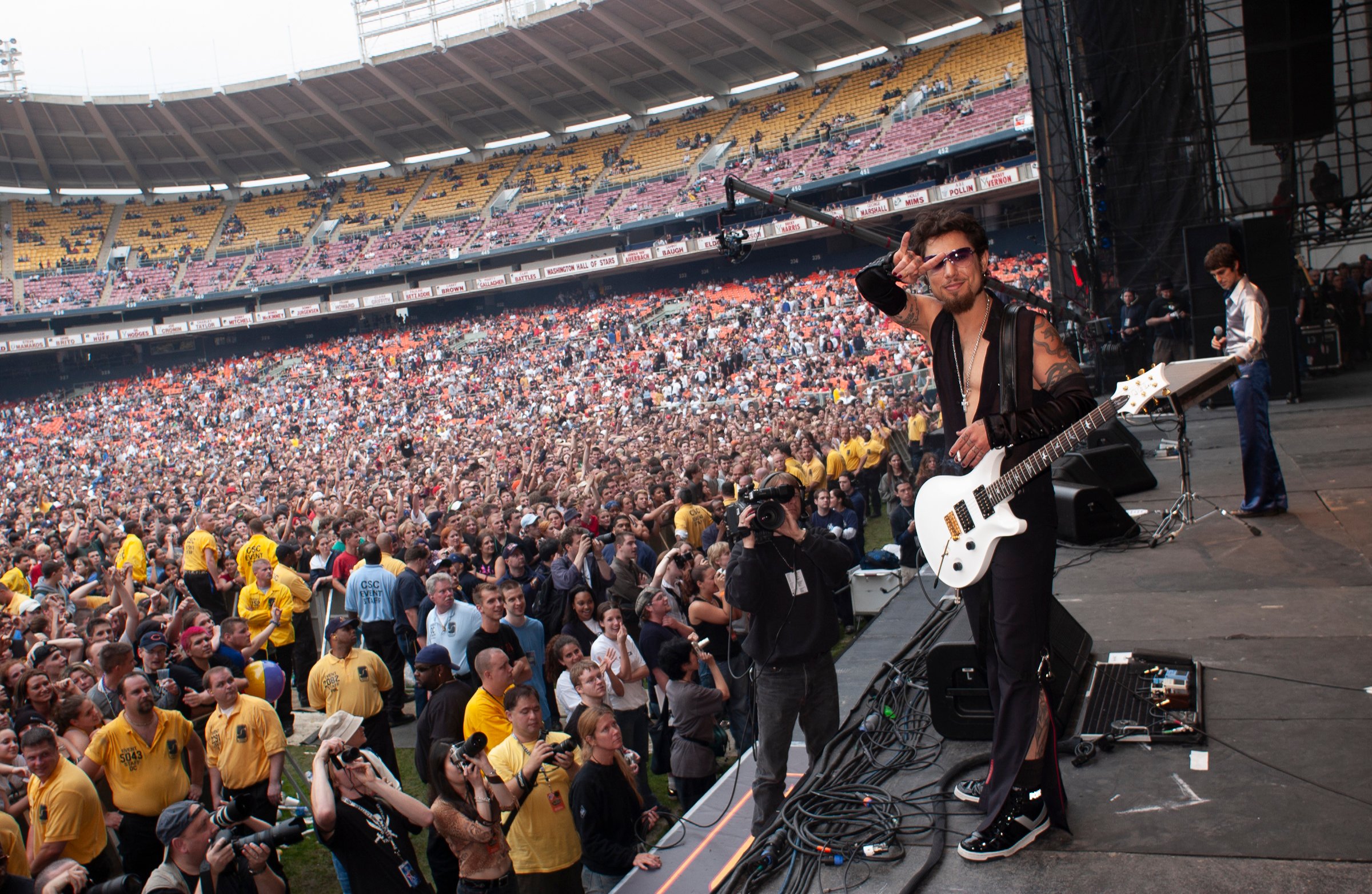
Bob Waugh, WHFS: When the rating success of WHFS was starting to wane a little bit in the late ’90s, the HFStival, honestly, was what kept that station on the air for as long as it did. Because it was profitable. In 2000, we moved it to FedEx Field. We had Rage Against the Machine and Stone Temple Pilots. That was massive. But there was a vibe at FedEx Field. Like when [then-Washington Commanders owner] Daniel Snyder came to the show, everything had to stop and the tunnel had to be cleared. His SUV pulls in and we were told, “Don’t look at Mr. Snyder.”
Alternative rock was turning into something darker and more aggressive—and crowds were sometimes following suit. The Woodstock ’99 festival in New York was marred by violence, rioting, multiple rapes and sexual assaults, and three deaths. While the HFStival never came close to that level of calamity, the vibes were souring. The British pop band Coldplay performed at the 2001 HFStival, which returned to RFK for a two-day show. Their set didn’t go well.
Waugh: Coldplay was selling a lot of records at the time. They wanted a prime spot, like around 6 o’clock at night. We tried to talk them out of that, because the HFStival crowd was a big mosh pit and a lot of drunk frat boys, and those guys getting up and singing “Yellow,” I just didn’t think was gonna go over that great at that time of day. However, that’s what ended up happening, and they didn’t have a good experience. People were throwing things at one point, [the band members] were completely bummed out. Later, they wrote a song about it.
Coldplay performed that song at FedEx Field in 2022.
Chris Martin, musician, Coldplay, live at FedEx Field: “HFS invited, and we got excited / So we came to Washington / But this was the age of nü metal / And our songs were a little more chill / We were missing the mark because we weren’t Linkin Park / What the fuck are we doing on this bill? / Now, I love those bands and their music / But their fans didn’t like us one bit / They did not like the mellow / Or the way we played ‘Yellow’ / And soon they were throwing all kinds of shit.”
Headlined by Eminem, the two-day 2002 HFStival was, in the words of the Washington Post, “marked by rambunctious audience behavior, including fights and aggressive dancing in a crowded area near the stage called the mosh pit.”
Waugh: Night would descend. Things would get a little crazy. Lots of drunk boys. For the first time in the history of the HFStival, we had a pretty serious injury. About three songs into [Eminem’s] set, a guy right in front of the stage in the mosh pit went into cardiac arrest. And the show was stopped. This guy was brought up onstage and defibrillated and then taken to the hospital. That show eventually resumed, but it was a huge downer. The very next day, some kid was up high in the stands at RFK. He decided he was going to walk on top of the railing for fun, and he slipped and fell a couple of floors. Luckily for him, he landed on a stack of wooden skids, which broke his fall. I was starting to feel like maybe this had run its course.
VII. Exile in Guyville
Robert Benjamin left his job as WHFS program director in 2003—and in January 2004, Bob Waugh also departed. The last HFStival at RFK took place on May 22, 2004, headlined by the Cure and Jay-Z.

Bob Waugh, WHFS: What started as a labor of love just kind of became this huge, pressure-filled responsibility.
In January 2005, WHFS abruptly abandoned its modern-rock format and was rebranded as “El Zol,” a Spanish-language station. The Baltimore Sun called the change “an act of mercy after a long death spiral,” noting that ratings had tanked, and WHFS had lost “much of the audience and spirit that had made it among the country’s most beloved and progressive stations.”
Pat Ferrise, WHFS: I was there till the bitter end. I was the last DJ.
WHFS’s corporate owners turned it into a streaming station playing new and old rock and HFStival performances. Fans protested, and WHFS later returned, sharing a frequency with a station that played talk radio during the day. Foo Fighters singer Dave Grohl called in to the zombie WHFS on its first day and offered to play the next HFStival.
However, the Washington Nationals now occupied RFK, which meant the festival needed a new home. A 2005 edition at Baltimore’s M&T Bank Stadium featured Foo Fighters, Coldplay, and Garbage. In 2006, Merriweather Post Pavilion hosted two shows headlined by Kanye West and the Strokes. The event then went dormant until 2010, when it returned to Merriweather in a severely diminished state—its biggest draws were Third Eye Blind, Billy Idol, and Ed Kowalczyk of Live. A final HFStival took place in 2011—despite the fact that WHFS no longer existed.
Kelly Collis, former morning host, 94.7 Fresh FM, and one of the emcees at the final HFStival: It was such a pathetic way to breathe life into something that had had its moment. I remember looking out to the crowd and there were 200 people there. It was really sad. The big sell was the Gin Blossoms. In 2011.
Waugh: It was painful to me, because I feel like it really fucked with our legacy. It would be unfair for me to say that those events sucked, because I didn’t go. But those events sucked.
VIII. Slanted and Enchanted
Despite its ignominious end, the HFStival lives on in the memories of Washingtonians—particularly those who came of age in the ’90s. Where else could you see local and national acts share a stadium stage? Or climb into a ribbed steel ball and be rolled against giant soft pins—fittingly known as “human bowling”—before ducking into a Rock the Vote tent between sets from Luscious Jackson and the Verve Pipe?

Rob Pegoraro, Washington Post journalist, 1993–2011: In retrospect, everything pre-2001 seems so much simpler. We’d kicked communism’s ass. We had a new President, Bill Clinton, who seemed like he couldn’t do anything wrong. And obviously, everything was more complicated than we thought—but from the perspective of spending ten hours in a concrete doughnut listening to a lot of music, you’re not going to notice.
Eric Axelson, the Dismemberment Plan: The funny thing is, like, we would play this big [Sunday] festival with all these special things and access. We’d leave that Tuesday for tour, and then suddenly, like, that Wednesday we’re playing in St. Louis for, like, ten people and trying to find a floor to sleep on. It was back to the reality of indie rock. I remember getting home [from the HFStival], sitting on my porch and thinking about what a wild Sunday it was. Just kind of sunburned and stuffed full of food. It was magical.

HFStival godfathers Bob Waugh and Robert Benjamin had a tradition: At the end of each show, they’d commandeer a golf cart and drive to the top of RFK Stadium. There, they’d sit in the farthest row from the stage—and enjoy their first beers of the day.
Bob Waugh, WHFS: I’d known [Ramones lead singer] Joey Ramone for many years. When the Ramones went on [stage] one year, just as we sat down, Joey Ramone is like, “This one’s for Bob Waugh.” And then they went into “Blitzkrieg Bop.” That’s seriously the highlight of my career.
Organizers of the revived HFStival at Nationals Park this fall hope to recapture the original’s spirit with a nostalgia-heavy lineup including Bush, Garbage, and the Postal Service.
Seth Hurwitz, chairman, I.M.P.: This was a huge tradition and beloved event here. Almost like a holiday. This is another chance to create something that people love.

After
businessman Jacob Einstein bought a Bethesda easy-listening radio station in the late 1960s and encouraged his DJs to play whatever they wanted, WHFS cultivated a Washington-area audience of oddballs and music obsessives. But in 1991, Nirvana’s Nevermind became an era-defining hit, and the station—which had long played what was then called “alternative rock”—was uniquely positioned to ride the musical and cultural waves left in the album’s wake.
Robert Benjamin joined WHFS as its program director around the same time, professionalizing its playlists as ratings skyrocketed. With sorority sisters singing along to the Butthole Surfers and minivans in the burbs rocking to Archers of Loaf, the time was right to bring alt-rock’s many tribes together—the gentle indie-rock kids, the moshing bros, the goths allergic to sunlight, the crusty punks with dogs on strings, the bewildered friends. WHFS already had thrown two Fourth of July barbecues at Lake Fairfax Park in Reston, but Benjamin thought the event could be much bigger.
He was right. Landing at RFK Stadium on July 3, 1993, the HFStival became an annual phenomenon, attracting an average of 58,000 people while serving as a template for similar shows across the country. Later, when the event moved to football stadiums outside the city and in Baltimore, as many as 90,000 people attended.
By the early aughts, however, the good vibes started to fade. The music got darker and angrier. So did the crowds. In 2005, WHFS abruptly went off the air, its call sign since bouncing between cities and formats. The HFStival sputtered and disappeared, Generation X’s brief moment of cultural relevance fading into a very on-brand disappointment.
Still, nostalgia persists—to the point that local concert giant I.M.P. has announced plans to revive the event at Nationals Park in the fall. More than a chance to see Foo Fighters, Garbage, and No Doubt perform on the same stage, the original HFStival was a case study of niche culture going mainstream, and an optimistic salve for a pessimistic generation.
Washingtonian spoke to musicians, on-air personalities, fans, and suits about the rise and fall of a you-had-to-be-there experience.
I. In Utero
WHFS’s tradition of freeform radio changed after Nirvana’s breakout, which showed major labels that they could vacuum up the audience that punk and indie bands had built. Suddenly, the quirky little station became a contender on Washington’s airwaves.

Bob Waugh, WHFS assistant program director, 1991–2004: We had this signature line: “99.1 WHFS: Less music by dead guys.”
Eric Axelson, musician, the Dismemberment Plan: All of us grew up listening to HFS. It was kind of a North Star for us because it wasn’t [classic-rock station] DC101 and it wasn’t [Top 40] Q107. It was playing R.E.M., it was playing the Alarm and stuff we weren’t gonna hear elsewhere.
Bill Barbot, musician, Jawbox: I grew up listening to HFS. That was where I learned about music, like, the first time I ever heard Mission of Burma.
Robert Benjamin, WHFS program director, 1991–2003: Alternative rock was about to explode. We brought in a number of really talented people. The festival grew out of that.
The station’s first Fourth of July festival was held at Lake Fairfax Park in 1990. Fifteen thousand attendees saw performers including Concrete Blonde and the Tragically Hip. The next year, 25,000 came to see a lineup that included the La’s and the Violent Femmes.
Benjamin: The [station] had done a basic Fourth of July show and picnic—fireworks, swimming. My thought was let’s make it be about a lot of bands and really identify it with the station. At the last moment, when we were designing T-shirts, I decided I didn’t want to be stuck doing a Fourth of July show every year. I just wrote down “HFStival on the Fourth of July.” And maybe we could move this thing somewhere else, make it bigger. So it was the second annual HFStival, even though there had never been one before.

Pat Ferrise and Dave Marsh, two former West Virginia University students who had landed jobs at WHFS, worked the 1991 event.
Pat Ferrise, WHFS music director and DJ, 1990–2005: The La’s played. I don’t want to say they stole a golf cart—
Dave Marsh, WHFS DJ, 1990–99: They stole a golf cart.
Ferrise: They commandeered a golf cart. They were 20-year-old crazy British guys.
Marsh: There was that pizza-box thing.
Axelson: There was a Domino’s stand, and people started ripping boxes in half and throwing them in the air. So it was raining cardboard and plastic bottles. It got weirdly scary for a minute.
In 1992, the HFStival moved to the Prince George’s Equestrian Center in Upper Marlboro. The lineup included the Soup Dragons, the Charlatans UK, They Might Be Giants, and local band Manifesto. Thirty-two thousand people attended.
Ferrise: It sold out pretty quickly.
Benjamin: I remember sitting in a trailer with state troopers and the racetrack people, and they were saying, “We’ve got to shut this down. There’s too many people coming.”
Waugh: There were massive traffic backups.
Axelson: The ground was just, like, dirt. It just felt like Pig-Pen from Charlie Brown.
Geoff Sanoff, musician, Edsel: Our bandmate Nick was the keyboard player in Manifesto, and [working as Manifesto’s crew] was an excuse to get in for free. It was so dusty, a really hot day, and they had this air-conditioned VIP area. And the idea that we could drink endless amounts of anything we wanted. It’s like, “Wow, now we’re playing with the big boys.”
Sohrab Habibion, musician, Edsel: I realized immediately that I never wanted to be on the other side.
II. Automatic for the People
Because of the 1992 event’s size, the Equestrian Center asked WHFS to find another venue for its next festival.

Robert Benjamin, WHFS: We talked to the people at [local concert-production company] Cellar Door. They kept saying, “We really think RFK Stadium is the place for you guys.” It didn’t feel like putting it in a stadium was right—we were concerned about the vibe. They said, “Come check out this Grateful Dead show we’re going to do.” It was interesting, because they took the tickets at the outer perimeter. Once you were in, you could go wherever you wanted—parking lots, you could sit in the stands, you could come down on the field.
Bob Waugh, WHFS: We thought long and hard and concluded that if we could get the right band to headline, we could give it a shot.
Benjamin and Waugh got a tip that the Australian band INXS might be amenable to headlining a festival at RFK.
Pat Ferrise, WHFS: They were on the other side of the apex, but they were still really big. Bob and I went to Philadelphia and met with them. They played in a small club. We went backstage afterwards, and [lead singer] Michael Hutchence was very quiet and nice. And the management, they’re being really serious. We’re thinking, “Hey, we’re offering you a chance to play a stadium. Come on.”
Waugh: I shared a limousine with Hutchence and [guitarist] Tim Farriss. We drove down to DC and went to Tower Records in Georgetown. And we announced that INXS was going to headline that year at HFStival.

WHFS booked a mix of acts it was championing at the time, like Stereo MC’s, Matthew Sweet, and the Posies, as well as heritage acts like Iggy Pop to broaden the festival’s appeal. Crucially, it set the ticket price at $12.
Benjamin: We wanted to be $1 a band. We sold out the show with about a week to spare.
Ferrise: That was part of the HFS relationship with the audience, like, “Hey, we’re all scrappy underdogs, no one’s trying to gouge you, these are some cool bands for not a lot of money.”
Local indie-rockers Velocity Girl, who’d recently signed to Nirvana’s old record label, Sub Pop, were tapped to open the show on July 3, 1993. Fifty-six thousand attended.
Jim Spellman, musician, Velocity Girl: We had to get there quite early. I remember how weird it was driving into the bowels of RFK. Most other bands had big buses and trucks, and we had our dinky Dodge van with the plywood loft in back.
Ferrise: I’d only seen [Velocity Girl] at the 9:30 Club. They sounded great [at RFK]. I was struck how they were able to pull it off, because playing a big stadium is a very different experience.
Spellman: After we finished playing, the rest of the day became a race to somehow stay drunk for eight hours. We quickly depleted our assigned allotment of booze. While Stereo MC’s was performing, we snuck into their dressing room and stole a bunch of beer. We stole a bottle of Jack Daniel’s from Matthew Sweet—apologies to him and his band.
III. Different Class
The festival returned to RFK in May 1994 with a crowd of 58,000 and two stages: an “inner” stage in the stadium for bigger acts (Cracker, Counting Crows, Pavement, Rollins Band, Toad the Wet Sprocket) and an “outer” stage in the parking lot for smaller ones (Edsel, Gigolo Aunts, the DC band Tuscadero).

Phil Satlof, musician, Tuscadero: We borrowed our friend’s Astro van—his mother was a florist. And we got lost because I don’t think any of us had ever driven to RFK before. There were big guys with headsets and clipboards. I don’t think we had played outdoors yet. There were probably four to five hundred people milling about—a lot of dudes with no shirt and ’90s haircuts.
Dave Marsh: Each DJ would be assigned to introduce a band, you would do the stage announcement. And so, Robert, in all of his wisdom, he would try to pair you up with a band who thought most fit what your image was.
Gina Crash: A lot of times people really didn’t see their favorite DJs unless they were up in front of a Jumbotron with 65,000 people. So they’d be like, “Oh, that’s what Crash looks like.” So it was definitely a different time.
Geoff Sanoff, musician, Edsel: I’d gotten into a car accident about a month before the show. And we each got four tickets. I needed to pay to get my car fixed, so I sold them for $300. I was going to sell my backstage pass—I could have gotten, like, $40 or $50—but I gave it away to some kids who were trying to get in, because I thought it would be funny to let them get backstage.
Sohrab Habibion, musician, Edsel: MTV covered it. We got interviewed. But you know, we were the first band and it was that thing, like, nobody gives a shit about anybody who’s playing in the parking lot except our friends.
Sanoff: My mom cared.

Inside the stadium, the crowds were much bigger—but the event still retained much of its low-fi charm.
Pat Ferrise, WHFS: Counting Crows was a cool moment. That day, it rained. I think we had to delay the show for a minute, but I just remember the rain adding a cool effect to their performance. It wasn’t like a downpour, it was just enough rain that it kind of seemed intentional.
Sean Daly, Washington Post pop-music critic, 2004–05: Toward the end of the event, a balmy DC night, surly seat dwellers started raining bottles at people on the field. My then-girlfriend decided we should go back to protect ourselves from the onslaught. She said, “Duck,” and we ducked! Then a bottle came at me—but I didn’t say, “Duck.” She got whacked in the noggin. So much for heroism!
IV. You’ve Come a Long Way, Baby
For the rest of the ’90s, the HFStival was a major event, drawing a who’s who of the decade’s headliners and one-hit wonders: Bush and Better Than Ezra, Everclear and Gin Blossoms, Beck and Jewel, Green Day and Jamiroquai, Wyclef Jean and Third Eye Blind, the Goo Goo Dolls and the Red Hot Chili Peppers.

Bob Waugh, WHFS: One thing that was a big help was a company called SoundScan, which measured record sales every day. All the record companies cared about was how many records they could sell. And what we saw on a pretty consistent basis was that any band that played the HFStival, that following Monday or Tuesday when the SoundScan report was released, their record sales were through the roof in DC.
To help bring in acts, WHFS staffers worked to make the backstage as comfortable as possible—no mean feat in an aging RFK Stadium.
Gina Crash, WHFS DJ, 1992–2002: I know a lot of people complain about RFK being in a state of disarray, but I feel like it always was in an endearing kind of way. You know, just little pieces of the roof would fall off while you’re talking.
Bill Barbot, Jawbox: It felt like a completely different venue to me. I had been to a couple of Redskins games when I was little because my dad’s company had season tickets. The environments of a football game at RFK versus a rock festival at RFK were so completely and utterly different. You feel compelled to fill up all this space.
Pat Ferrise, WHFS: The idea was to go above and beyond to make bands know how appreciated they were. The food was really good. And the whole setup just looked like you’re walking into a magical hippie restaurant by the sea.
Eric Axelson, the Dismemberment Plan: Aveda had a setup backstage where you could get haircuts or a massage. I was on the chair next to [Echo & the Bunnymen singer] Ian McCulloch. He was getting a trim, and his manager was chatting him up before their set about like the right time to take his sunglasses off for maximum impact. He’s like, “Right mate, during the chorus, pull them off right when the chorus kicks in, and the crowd’s going to go batshit.” And he did, and they did.
Waugh: We went out of our way to honor their hospitality riders to the T. Artists would fuck around and request things just to see if we would get it for them. Everclear one year said, “We would like a small dog.” And we made it happen.

Dave Marsh, WHFS: At a big festival, the bands show up, do their sets, and then leave. At HFStival, the bands would stay the entire time. I remember Iggy Pop saying in an interview that day, “Yeah, it’s great, it’s like a giant hang.”
Barbot: That’s kind of what the HFStival did: It threw a bunch of us who weren’t in that world into that world, and tried to see what would happen.
Waugh: The lead singer of Soul Asylum, Dave Pirner, was dating Winona Ryder [in 1995]. My walkie-talkie goes off and I’m told that Winona Ryder would like to have a word with Les Claypool of Primus. And I’m like, “Okay.” Winona Ryder confronts Les Claypool and says, “What the fuck?” Because Primus had this song out called “Wynona’s Big Brown Beaver.” It’s not even spelled the same way as her name. I’m just standing there watching this, thinking, What the fuck is happening here? Les Claypool just kind of laughed it off. She had her say and split. I never saw her again that day.
V. Viva! La Woman
The HFStival had its share of snafus and drama. In 1996, Jewel walked off the stage in the middle of her second song after getting hit in the chest by a Frisbee. In 1999, the Red Hot Chili Peppers nearly refused to play after hearing that the band preceding them, the Offspring, was planning to ask the crowd to pelt the stage with trash at the end of their set. Then there was Courtney Love, a “special guest” at the 1995 event alongside Tony Bennett.

Juliana Hatfield, musician, the Juliana Hatfield Three: She was her usual hot glorious mess of a whirlwind. And it was exciting. You know, she had that real rock thing and voice.
Bob Waugh, WHFS: I’ve got a million stories that nobody knows, like Courtney Love having to share a dressing room with Tony Bennett and flashing him, and Tony Bennett just being completely nonplussed.
Dave Marsh, WHFS: I didn’t see the flashing. But they were both there. I step out into the hallway and there’s nobody in it, except Tony is coming this way. Courtney is coming the other way. I’m in the middle. She was dressed in this kind of negligee, and Tony was in an ascot and a smoking jacket. Courtney was almost hanging on the wall. They acknowledged each other and carried on.
Robert Benjamin, WHFS: She came out and did a couple songs and then jumped into the mosh pit.
Washington Post, June 4, 1995: “[Love] emerged a minute later, her dress shredded, and unleashed a burst of expletives at the audience, challenging one member, ‘Come up here—I’ll kick your butt!’ And then she was gone, hustled offstage by a few beefy security types.”
Hatfield: We decided that right after our last song, we were all going to dive into the crowd together. The crowd just caught us and put us all back on the stage. And then we just walked out because it was pretty successful.
Benjamin: Tony Bennett’s philosophy was there’s good music and bad music. And there’s no reason why people that like the Red Hot Chili Peppers can’t like Tony Bennett as well. The crowd was very active in the mosh pit. I remember talking to his son, and he said, ‘Don’t embarrass my father.’ The Ralph Sharon Trio started playing. Tony walked out, grabbed the mic like a pro. The crowd went completely reverent. He just killed it in front of 50,000 people that had spent a good bulk of the day moshing.
VI. The Downward Spiral
Around the turn of the millennium, the HFStival peaked—the 1999 event was actually two shows, one at Baltimore’s PSINet Stadium (now M&T Bank Stadium) in the spring and one at RFK in the fall, while the 2000 show moved to FedEx Field in Maryland and drew 90,000 people. Still, trouble was brewing: Rock was losing its cultural cachet, and so was HFS.

Bob Waugh, WHFS: When the rating success of WHFS was starting to wane a little bit in the late ’90s, the HFStival, honestly, was what kept that station on the air for as long as it did. Because it was profitable. In 2000, we moved it to FedEx Field. We had Rage Against the Machine and Stone Temple Pilots. That was massive. But there was a vibe at FedEx Field. Like when [then-Washington Commanders owner] Daniel Snyder came to the show, everything had to stop and the tunnel had to be cleared. His SUV pulls in and we were told, “Don’t look at Mr. Snyder.”
Alternative rock was turning into something darker and more aggressive—and crowds were sometimes following suit. The Woodstock ’99 festival in New York was marred by violence, rioting, multiple rapes and sexual assaults, and three deaths. While the HFStival never came close to that level of calamity, the vibes were souring. The British pop band Coldplay performed at the 2001 HFStival, which returned to RFK for a two-day show. Their set didn’t go well.
Waugh: Coldplay was selling a lot of records at the time. They wanted a prime spot, like around 6 o’clock at night. We tried to talk them out of that, because the HFStival crowd was a big mosh pit and a lot of drunk frat boys, and those guys getting up and singing “Yellow,” I just didn’t think was gonna go over that great at that time of day. However, that’s what ended up happening, and they didn’t have a good experience. People were throwing things at one point, [the band members] were completely bummed out. Later, they wrote a song about it.
Coldplay performed that song at FedEx Field in 2022.
Chris Martin, musician, Coldplay, live at FedEx Field: “HFS invited, and we got excited / So we came to Washington / But this was the age of nü metal / And our songs were a little more chill / We were missing the mark because we weren’t Linkin Park / What the fuck are we doing on this bill? / Now, I love those bands and their music / But their fans didn’t like us one bit / They did not like the mellow / Or the way we played ‘Yellow’ / And soon they were throwing all kinds of shit.”
Headlined by Eminem, the two-day 2002 HFStival was, in the words of the Washington Post, “marked by rambunctious audience behavior, including fights and aggressive dancing in a crowded area near the stage called the mosh pit.”
Waugh: Night would descend. Things would get a little crazy. Lots of drunk boys. For the first time in the history of the HFStival, we had a pretty serious injury. About three songs into [Eminem’s] set, a guy right in front of the stage in the mosh pit went into cardiac arrest. And the show was stopped. This guy was brought up onstage and defibrillated and then taken to the hospital. That show eventually resumed, but it was a huge downer. The very next day, some kid was up high in the stands at RFK. He decided he was going to walk on top of the railing for fun, and he slipped and fell a couple of floors. Luckily for him, he landed on a stack of wooden skids, which broke his fall. I was starting to feel like maybe this had run its course.
VII. Exile in Guyville
Robert Benjamin left his job as WHFS program director in 2003—and in January 2004, Bob Waugh also departed. The last HFStival at RFK took place on May 22, 2004, headlined by the Cure and Jay-Z.

Bob Waugh, WHFS: What started as a labor of love just kind of became this huge, pressure-filled responsibility.
In January 2005, WHFS abruptly abandoned its modern-rock format and was rebranded as “El Zol,” a Spanish-language station. The Baltimore Sun called the change “an act of mercy after a long death spiral,” noting that ratings had tanked, and WHFS had lost “much of the audience and spirit that had made it among the country’s most beloved and progressive stations.”
Pat Ferrise, WHFS: I was there till the bitter end. I was the last DJ.
WHFS’s corporate owners turned it into a streaming station playing new and old rock and HFStival performances. Fans protested, and WHFS later returned, sharing a frequency with a station that played talk radio during the day. Foo Fighters singer Dave Grohl called in to the zombie WHFS on its first day and offered to play the next HFStival.
However, the Washington Nationals now occupied RFK, which meant the festival needed a new home. A 2005 edition at Baltimore’s M&T Bank Stadium featured Foo Fighters, Coldplay, and Garbage. In 2006, Merriweather Post Pavilion hosted two shows headlined by Kanye West and the Strokes. The event then went dormant until 2010, when it returned to Merriweather in a severely diminished state—its biggest draws were Third Eye Blind, Billy Idol, and Ed Kowalczyk of Live. A final HFStival took place in 2011—despite the fact that WHFS no longer existed.
Kelly Collis, former morning host, 94.7 Fresh FM, and one of the emcees at the final HFStival: It was such a pathetic way to breathe life into something that had had its moment. I remember looking out to the crowd and there were 200 people there. It was really sad. The big sell was the Gin Blossoms. In 2011.
Waugh: It was painful to me, because I feel like it really fucked with our legacy. It would be unfair for me to say that those events sucked, because I didn’t go. But those events sucked.
VIII. Slanted and Enchanted
Despite its ignominious end, the HFStival lives on in the memories of Washingtonians—particularly those who came of age in the ’90s. Where else could you see local and national acts share a stadium stage? Or climb into a ribbed steel ball and be rolled against giant soft pins—fittingly known as “human bowling”—before ducking into a Rock the Vote tent between sets from Luscious Jackson and the Verve Pipe?

Rob Pegoraro, Washington Post journalist, 1993–2011: In retrospect, everything pre-2001 seems so much simpler. We’d kicked communism’s ass. We had a new President, Bill Clinton, who seemed like he couldn’t do anything wrong. And obviously, everything was more complicated than we thought—but from the perspective of spending ten hours in a concrete doughnut listening to a lot of music, you’re not going to notice.
Eric Axelson, the Dismemberment Plan: The funny thing is, like, we would play this big [Sunday] festival with all these special things and access. We’d leave that Tuesday for tour, and then suddenly, like, that Wednesday we’re playing in St. Louis for, like, ten people and trying to find a floor to sleep on. It was back to the reality of indie rock. I remember getting home [from the HFStival], sitting on my porch and thinking about what a wild Sunday it was. Just kind of sunburned and stuffed full of food. It was magical.

HFStival godfathers Bob Waugh and Robert Benjamin had a tradition: At the end of each show, they’d commandeer a golf cart and drive to the top of RFK Stadium. There, they’d sit in the farthest row from the stage—and enjoy their first beers of the day.
Bob Waugh, WHFS: I’d known [Ramones lead singer] Joey Ramone for many years. When the Ramones went on [stage] one year, just as we sat down, Joey Ramone is like, “This one’s for Bob Waugh.” And then they went into “Blitzkrieg Bop.” That’s seriously the highlight of my career.”
Organizers of the revived HFStival at Nationals Park this fall hope to recapture the original’s spirit with a nostalgia-heavy lineup including Bush, Garbage, and the Postal Service.
Seth Hurwitz, chairman, I.M.P.: This was a huge tradition and beloved event here. Almost like a holiday. This is another chance to create something that people love.
This article appears in the July 2024 issue of Washingtonian.


